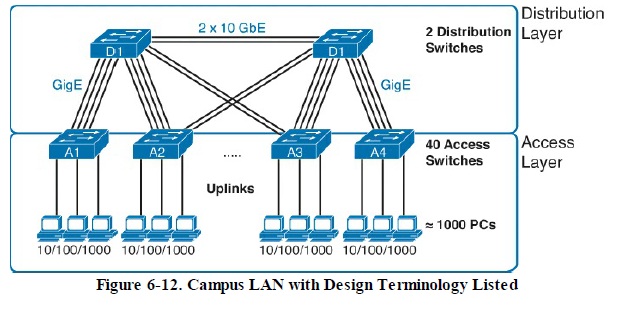- Cisco Community
- Technology and Support
- Networking
- Switching
- Please Help
- Subscribe to RSS Feed
- Mark Topic as New
- Mark Topic as Read
- Float this Topic for Current User
- Bookmark
- Subscribe
- Mute
- Printer Friendly Page
Please Help
- Mark as New
- Bookmark
- Subscribe
- Mute
- Subscribe to RSS Feed
- Permalink
- Report Inappropriate Content
12-23-2013 11:47 AM - edited 03-07-2019 05:13 PM
Hello guys!
I am studying for CCENT using Wendell Odom’s book. So, I got to the Building Ethernet LANs with Switches section, where I stumbled on of the sections. Here goes a passage from the book:
Figure 6-12 shows a typical design of a large campus LAN, with the terminology included in the figure. This LAN has around 1000 PCs connected to switches that support around 25 ports each. Explanations of the terminology follow the figure.

Using designs that connect a larger number of access switches to a small number of distribution switches reduces cabling needs while still allowing all devices to send data to all other devices in the LAN. For example, in Figure 6-12, the design could use a pair of links from each access switch to each of the two distribution switches, providing a great deal of redundancy. With four links for each of 40 access switches, the design uses 160 uplinks. If the design instead did not use distribution switches, to connect a single link between each pair of access switches would require 780 links.
I have a few questions regarding this Figure.
1). How did he get 780 link?
2). Can't we just connect those 40 switches using just 1 cable for each pair of switches. This will require only 39 cables. So, why does he say 780?
3). What's the actual purpose for Distribution Switches.
Thanks in advance.
Eddy.
- Labels:
-
LAN Switching
- Mark as New
- Bookmark
- Subscribe
- Mute
- Subscribe to RSS Feed
- Permalink
- Report Inappropriate Content
12-23-2013 02:49 PM
1. n*(n-1)/2 If you wanted to create a full mesh with all 40 switches it would take 780 links. Replace n with 40 in the formula.
2. Can you? Yes. Would you? No. What about redundancy? Would a single uplink provide enough bandwidth for all the clients? Think about oversubscription rates. Typical access layer is around 20:1. A single uplink would be about 48:1.
3. Many things; routing, SVI's, ACL's, summarization, QoS, Security, etc. As you learn more you'll start to see their purpose.
- Mark as New
- Bookmark
- Subscribe
- Mute
- Subscribe to RSS Feed
- Permalink
- Report Inappropriate Content
12-24-2013 04:12 PM
Thanks Collin. I think I understand it now.
- Mark as New
- Bookmark
- Subscribe
- Mute
- Subscribe to RSS Feed
- Permalink
- Report Inappropriate Content
12-24-2013 06:12 PM
Disclaimer
The Author of this posting offers the information contained within this posting without consideration and with the reader's understanding that there's no implied or expressed suitability or fitness for any purpose. Information provided is for informational purposes only and should not be construed as rendering professional advice of any kind. Usage of this posting's information is solely at reader's own risk.
Liability Disclaimer
In no event shall Author be liable for any damages whatsoever (including, without limitation, damages for loss of use, data or profit) arising out of the use or inability to use the posting's information even if Author has been advised of the possibility of such damage.
Posting
#3 To minimize the number of switch hops, and links, to allow transit traffic from any host to any other host.
If you have 40 access switches, how might you interconnect them? Well you might do a full mesh, i.e. each switch has a link to every other switch. Of course that means each switch requires 39 ports to link to each other switch, especially difficult to do on 25 port switches, but if you did it would provide optimal performance but require the most links.
You could connect the 40 switches in a daisy chain or ring, then you only need about two links for each switch. However, some hosts on the top and bottom of the chain need to transit all the switches in the chain which add switch latency and will likely congest in the middle switches.
With a single distribution switch, we only need one link from each access switch, and we only incur one additional hop.
#2 Yes, if you connect to a single distribution switch, as I just described. An additional link and another distribution switch provide a redundant path. (BTW, if hosts are user PCs, often you don't really need more than one gig uplink to support a 25 port edge switch, even if edge ports are gig too.)
#1 The 780 would be for a full mesh (see Collin's explanation), but as I also described, 25 port devices wouldn't have enough ports to full mesh 40 devices.
Discover and save your favorite ideas. Come back to expert answers, step-by-step guides, recent topics, and more.
New here? Get started with these tips. How to use Community New member guide